Competition Rules &
Interpretation 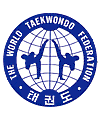 Printed on
January 11, 1999 The World Taekwondo Federation
1. Purpose
2. Application
3. Competition Area
4. Contestants
5. Weight
Divisions
6. Classification and
Methods of Competition
7. Duration of the
Contest
8. Drawing Lots
9. Weigh-In
10. Procedures
of the Contest
11. Permitted Techniques and
Areas
12. Valid Points
13. Scoring and Publication
14. Prohibited Acts
15. Decision of Superiority
16. Decisions
17. Knock
Down
18. Procedures in the Event of a Knock
Down
19. Procedures for Suspending the
Match
20. Referees and Judges
21. Recorder
22.
Assignment of Officials
23. Other matters not
specified in the Rules
24.
Arbitration
Referee's Hand
Signals
Taekwondo Terms
The purpose of
the Competition Rules is to manage fairly and smoothly all matters
pertaining to competitions of all levels to be promoted and/or organized
by the WTF, Regional Unions and member National Associations, ensuring
the application of standardized rules.
(Interpretation)
The objective of Article 1 is to ensure the
standardization of all Taekwondo competitions worldwide. Any competition
not following the fundamental principles of these rules cannot be
recognized as Taekwondo competition.
The Competition Rules shall apply to all the competitions to be
promoted and/or organized by the WTF, each Regional Union and member
National Association. However, any member National Association wishing
to modify some part of the Competition Rules must first gain the
approval of the WTF. (Explanation #1)
First gain
the approval:
Any organization desiring to make a change in some
portion of the existing rules must submit to the WTF the contents of the
desired amendment along with the reasons for the desired change.
Approval for any changes in these rules must be received from the WTF
one month prior to the scheduled competition. (Explanation #2)
1) Change of weight category, 2) increase or decrease of the number of
IRs, 3) change of positions for the Inspector, Recorder and Commission
Doctor, etc., and 4) duration of contest, etc. are subjects to be
included in the category of subjects which may be modified after first
gaining the approval of the WTF; however, such matters as valid points,
warnings and deductions, and the competition area are not to be changed
under any circumstances whatever.
The Competition Area shall measure 12m x 12m in metric system and
have a flat surface without any obstructing projections.
The Competition Area shall be covered with an elastic mat. However,
the Competition Area may be installed on a platform 0.5m - 0.6m high
from the base, if necessary, and the outer part of the Boundary Line
shall be inclined with a gradient of less than 30 degrees for the safety
of the contestants.
- Demarcation of the Competition Area
- The 8m x 8m area in the inner part of the Competition Area of 12m x
12m shall be called the Contest Area and the outer part of the Contest
Area shall be called the Alert Area.
- The demarcation of the
Contest Area and the Alert Area shall be distinguished by the different
colors of the two areas' surface, or indicated by a white line 5cm wide
when the entire surface is one color.
- The demarcating line
between the Contest Area and the Alert Area shall be called the Alert
Line and the marginal line on the Competition Area shall be called the
Boundary Line.
- Indication of Positions
- Position of the Referee
The position of the Referee shall be marked at a point 1.5m back from
the center point of the Competition Area to the third Boundary Line and
designated as the Referee's Mark. - Position of the
Judges
The position of the 1st judge shall be marked at a point 0.5m outwards
from the center of the 1st Boundary Line facing the center point of the
Competition Area and the position of the 2nd judge shall be marked 0.5m
outwards from the bottom corner of the second Boundary Line facing the
center of the Competition Area. The position of the 3rd judge shall be
marked at the opposite point of the 4th Boundary Line with the position
of the 2nd judge. - Position of the Recorder
The position of the Recorder shall be marked at a point 1.5m back from
the position of the 1st judge and 3m to the left. - Position of
the Commission Doctor
The position of the Commission Doctor shall be marked at a point 6m to
the right side of the position of the Recorder. - Position
of the Contestants
The position of the Contestants shall be
marked at a point 1m to the respective left and right sides from the
center point of the Competition Area facing towards the position of the
1st Judge. The right side shall be the Blue Contestant's Mark and the
left side shall be the Red Contestant's Mark.
- Position of the Coaches
The position of the Coaches shall
be marked at a point 1m away from the center point of the Boundary Line
of each contestant's side. - Position of the Inspection
Desk
The position of the Inspection Desk shall be near the
entrance of the Competition Area for inspection of the contestant's
protective equipment. (Explanation
#1)
Elastic mat:
The degree of elasticity of the mat must be
approved by the WTF before the competition. (Explanation #2)
Competition Platform:
The platform should be built according to the
following insert diagram. 
Diagram of Competition Area 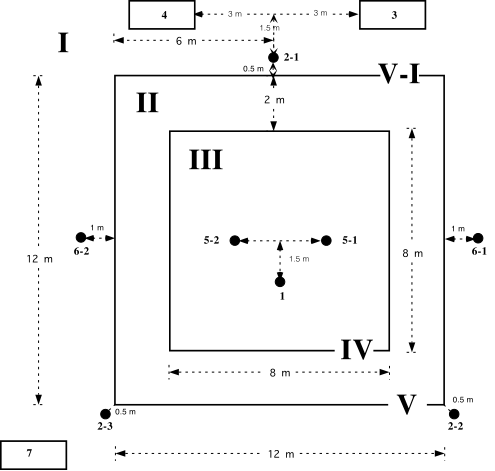
| I | Competition Area |
| II | Alert Area |
| III | Contest Area |
| IV | Alert Line |
| V | Boundary Line |
| V-I | 1st Boundary Line (* 2nd, 3rd and 4th
Boundary Lines clockwise) |
| 1. |
Referee's Mark |
| 2. |
Judge's Mark |
| 3. |
Recorder's Mark |
| 4. |
Commission Doctor's Mark |
| 5-1. |
Blue Contestant's Mark |
| 5-2. |
Red Contestant's Mark |
| 6-1. |
Blue Coach's Mark |
| 6-2. |
Red Coach's Mark |
| 7. |
Inspection Desk |
(Explanation #3)
Color:
The
color scheme of the mat's surface must avoid giving harsh reflection, or
be tiring to the contestant's or spectator's eyesight. The color scheme
must also be appropriately matched to the competitors' equipment,
uniform, and the competition surface. (Explanation #4)
The Alert
Line:
In principle, the alert line should be a white color.
However, according to the prevailing circumstances, another color may be
used as long as it is not an impediment to the competition.
(Explanation #5)
Inspection Desk:
At the Inspection Desk, the
inspector checks if all the materials worn by the contestant are the WTF
approved and fit the contestant properly. In case they are found to be
inappropriate, the contestant shall be kept from entering the contest.
(Guidelines for Officiating 1)
Judgment of the validity of
techniques is related to the boundaries of the Competition Area and is
dependent of the timing of the referee's declaration of "Kal-yeo." Any
actions occurring before the declaration of "Kal-yeo" are, in principle,
valid without consideration to the location where the actions occurred.
The referee bases the declaration of "Kal-yeo" on the relative
position of the contestants to the Alert Line, and the contestants and
judges base their respective actions and decisions partially on the
referee's declaration of "Kal-yeo." The referee's criterion for the
declaration of "Kal-yeo" is the point at which one foot of either
contestant crosses the Alert Line. To declare "Kal-yeo" in the absence
of violation or safety consideration, or before one foot of either
contestant crosses the Alert Line is irregular; however, depending on
the circumstances of the match, these instantaneous decisions follow the
judgment of the referee. When the referee deems it appropriate to
allow the match to continue uninterrupted until that instant when both
contestants have completely crossed over the Alert Line, the referee may
do so and can declare "Kal-yeo" at his/her discretion. (Guidelines
for Officiating 2)
- The referee must have full
understanding of the Competition Area's dimensions and of the
application of these dimensions in officiating.
- The referee must utilize the full limits of the Competition Area in
order to avoid excessive interruption of the match. However, when a
contestant leaves the Alert Area for the purpose of negative game
management or to avoid the exchange of techniques, the referee must
declare "Kal-yeo" and assess a penalty.
- When both feet of both contestants have crossed the Alert Line the
referee must declare "Kal-yeo" and, if there is any hesitation on the
part of the referee to declare "Kal-yeo" in this situation,
responsibility for any occurrence must be borne by the referee.
- Qualification of Contestants
- Holder of the nationality of the participating team.
- One recommended by the national Taekwondo association.
-
Holder of Taekwondo Dan certificate issued by the Kukkiwon/WTF, and in
case of World Junior Taekwondo Championships, holder of Kukkiwon
Poom/Dan certificate aged 14 through 17 years old based on the year when
the Championships are held.
(Interpretation)
The age limits for World Junior Championships is based on the year, not
on the date, when the Championships are held, which shall be between 14
through 17 years old. For instance, in case that the Championships
are held on September 9, 1998, those contestants born between January 1,
1981 and December 31, 1984 are eligible to participate.
- The Costume for Contestants
- The contestant shall wear a Taekwondo uniform (Dobok) and protectors
recognized by the WTF.
- The contestant shall wear the trunk
protector, head protector, groin guard, forearm and shin guards before
entering the contest area and the groin guard, forearm and shin guards
shall be worn inside the Taekwondo uniform, and the contestant shall
bring the WTF-approved protectors for personal use
- Medical Control
- The use or administration of drugs or
chemical substances described in the IOC doping by-laws is prohibited.
- The WTF may carry out any medical testing deemed necessary to
ascertain if a contestant has committed a breach of this rule, and any
winner who refuses to undergo this testing or who proves to have
committed such a breach shall be removed from the final standings, and
the record shall be transferred to the contestant next in line in the
competition standings.
- The organizing committee shall be liable
for arrangements to carry out medical testing.
(Interpretation)
A contestant's eligibility is established by
meeting all three requirements listed above in Section 1, "Qualification
of Contestants." (Explanation #1)
Holder of the nationality of
the participating team:
When a contestant is a representative of a
national team, his/her nationality is decided by citizenship of the
country he/she is representing before submission of the application to
participate. Verification of citizenship is done by inspection of the
passport. In the event nationality of a competitor holding more than
one citizenship causes conflict, the competitor shall choose the
participating team where he/she belongs to.
1. Weights are divided into male and female divisions.
2. Weight divisions are divided as follows:
|
Male Division |
Female Division |
| Fin |
Not exceeding 54 kg
|
Not exceeding 47 kg
|
| Fly |
Over 54 kg not exceeding 58 kg
|
Over 47 kg not exceeding 51 kg
|
| Bantam |
Over 58 kg not exceeding 62 kg
|
Over 51 kg not exceeding 55 kg
|
| Feather |
Over 62 kg not exceeding 67 kg
|
Over 55 kg not exceeding 59 kg
|
| Light |
Over 67 kg not exceeding 72 kg
|
Over 59 kg not exceeding 63 kg
|
| Welter |
Over 72 kg not exceeding 78 kg
|
Over 63 kg not exceeding 67 kg
|
| Middle |
Over 78 kg not exceeding 84 kg
|
Over 67 kg not exceeding 72 kg
|
| Heavy |
Over 84 kg
|
Over 72 kg
|
3. Weight divisions for the Olympic Games are divided as follows :
| Male Division | Female
Division |
| | Not
exceeding 58 kg
| Not exceeding 49 kg
|
| | Over
58 kg not exceeding 68 kg
| Over 49 kg not exceeding 57
kg
|
| | Over
68 kg not exceeding 80 kg
| Over 57 kg not exceeding 67
kg
|
| | Over
80 kg
| Over 67 kg
|
4. Weight divisions for the World Junior Championships are divided as
follows :
| Male Division | Female
Division | | Fin | Not exceeding 45
kg
| Not exceeding 42 kg
|
| Fly | Over 45 kg not exceeding 48
kg
| Over 42 kg not exceeding 44 kg
|
| Bantam | Over 48 kg not exceeding 51
kg
| Over 44 kg not exceeding 46 kg
|
| Feather | Over 51 kg not exceeding 55
kg
| Over 46 kg not exceeding 49 kg
|
| Light | Over 55 kg not exceeding 59
kg
| Over 49 kg not exceeding 52 kg
|
| Welter | Over 59 kg not exceeding 63
kg
| Over 52 kg not exceeding 55 kg
|
| Light Middle | Over 63 kg not exceeding 68
kg
| Over 55 kg not exceeding 59 kg
|
| Middle | Over 68 kg not exceeding 73
kg
| Over 59 kg not exceeding 63 kg
|
| Light Heavy | Over 73 kg not exceeding 78
kg
| Over 63 kg not exceeding 68 kg
|
| Heavy | Over 78 kg
| Over 68
kg
|
(Interpretation)
- A Taekwondo tournament is a competition which is decided,
within the rules, by direct physical contact and forceful physical
collisions between contestants. In order to reduce the impact of the
inequality in relative factors between contestants and ensure safety as
well as create equal conditions for the exchange of techniques, the
weight division system was established.
- The division of men and
women into separate categories, men competing against men, and women
competing against women, is a fundamental rule.
(Explanation #1)
Not exceeding:
The weight limit is defined
by the criterion of two decimal places away from the stated limit (in
hundredths). For example, not exceeding 50 kg is established as until
50.00 kg inclusive of 50.009 with 50.01 being over the limit.
(Explanation #2)
Over:
Over the 50.00 kg mark occurs at the
50.01 kg reading and 49.99 kg is regarded as insufficient, resulting in
disqualification.
- Competitions are
divided as follows:
- Individual competition shall normally be
between contestants in the same weight class. When necessary, adjoining
weight classes may be combined to create a single classification.
- Team Competition -- Systems of Competition
(1) Five contestants by weight classification with the following
category:
| Male Division | Female Division |
Not exceeding 54 kg
| Not exceeding 47
kg
| Over 54 kg not exceeding 63
kg
| Over 47 kg not exceeding 54 kg
|
Over 63 kg not exceeding 72 kg
| Over 54 kg not
exceeding 61 kg
| Over 72 kg not exceeding 82
kg
| Over 61 kg not exceeding 68 kg
|
Over 82 kg
| Over 68 kg
|
(2) Eight (8) contestants by weight classification.
(3) Four (4)
contestants by weight classification. (Consolidation of the eight
weight classifications into four weight categories by combining two
adjacent weight classes.)
- Systems of competition are divided as follows:
- Single elimination tournament system
- Round robin system
- Taekwondo competition of the Olympic Games shall be conducted in
individual competition system between contestants.
- All international-level competitions recognized by the WTF shall be
formed with participation of at least 4 countries with no less than 4
contestants in each weight class, and any weight class with less than 4
contestants cannot be recognized in the official results.
(Interpretation)
- In the tournament system,
competition is founded on an individual basis. However, the team
standings can also be determined by the sum of the individual standings
according to the overall scoring method.
- In the team competition
system, the outcome of each team competition is determined by the
individual team results.
(Explanation #1)
Consolidation of the
weight divisions:
The method of consolidation and the names of the
consolidated divisions are as follows:
| Division Designation |
| Fin / Fly |
Fly (Consolidated) |
| Bantam / Feather |
Feather (Consolidated) |
| Light / Welter |
Welter (Consolidated) |
| Middle / Heavy |
Heavy (Consolidated) |
(Explanation #2)
Eight weight
class format:
According to competition in eight weight classes, the
team winning five or more divisions is victorious. In the event that the
team match are not decided due to a tie score (four to four), each team
shall designate a representative to fight a tie-break match. In this
format, contestants may not be substituted.
(Interpretation)
- In the above format,
if before all matches have been conducted, one team achieves a majority
of victories, the remaining matches should, in principle, also be
conducted. If the losing team wishes to forfeit the remaining matches,
the result shall be recorded as loss due to disqualification without
consideration of the accumulated record.
The duration of the contest shall be three rounds of three minutes
with one minute of rest between rounds in male and female divisions with
that of World Junior Championships being three rounds of two minutes
with one minute of rest between rounds. However, the duration of the
contest my be shortened to three rounds of two minutes with one minute
of rest between rounds with the approval of the WTF.
- The drawing of lots shall be conducted one
day prior to the first competition in the presence of the WTF officials
and the representatives of the participating nations, and the drawing of
lots shall be done from Fin weight up in the English alphabetical order
of the official names of the participating nations.
- Officials shall be designated to draw lots on behalf of the
officials of participating nations not present at the drawing.
- The order of the draw may be changed according to the decision of
the Head of Team meeting.
- Weigh-in of the contestants on the day of competition
shall be completed one hour prior to the competition.
- During weigh-in, the male contestant shall wear underpants and the
female contestant shall wear underpants and brassiere. However, weigh-in
may be conducted in the nude in the case that the contestant wishes to
do so.
- Weigh-in shall be made once, however, one more weigh-in is granted
within the time limit for official weigh-in to the contestant who did
not qualify the first time.
- So as not to be disqualified during official weigh-in a scale, the
same as the official one, shall be provided at the contestants' place of
accommodation or at the arena for preweigh-in.
(Explanation #1)
The contestants on the day of competition:
This is defined as those contestants who are listed to compete on a
scheduled day by the Organizing Committee or the WTF. One hour prior
to competition:
The time for weigh-in will be previously decided
and announced by the Organizing Committee prior to the competition. The
weigh-in must be completed, without exception, one hour prior to the
start of the competition. (Explanation #2)
A separate site for
the weigh-in shall be installed for the female contestants, whose
weigh-in must be conducted by a female official in charge.
(Explanation #3)
Disqualification during official weigh-in:
When a competitor is disqualified at the initial weigh-in, that
competitor's participation point cannot be received. (Explanation
#4)
A scale, the same as the official one:
The practice scale
must be of the same type and calibration as that of the official scale
and these facts must be verified previously to the competition by the
Organizing Committee.
- Call for Contestants
The name of the contestants shall be announced three times beginning
three minutes prior to the scheduled start of the contest. The
contestant who fails to appear in the contest area within one minute
after the scheduled start of the competition shall be regarded as
withdrawn.
- Physical and Costume Inspection
After being called, the contestants shall undergo physical and costume
inspection at the designated inspection desk by the inspector designated
by the WTF, and the contestant shall not show any signs of aversion, and
also shall not bear any materials which could cause harm to the other
contestant.
- Entering the Competition Area
After inspection, the contestant shall enter into the waiting position
with one coach.
- Start and End of the Contest
The contest in each round shall begin with the declaration of "Shi-jak"
(start) by the referee and shall end with the declaration of "Keu-man"
(stop) by the referee.
- Procedure Before the Beginning and End of the Contest
- The contestants shall face each other and make a standing bow at the
referee's command of "Char-yeot" (attention) and " Kyeong-rye" (bow) . A
standing bow shall be made from the natural standing posture of
"Char-yeot" by bending the waist to an angle of more than 30 degrees
with the head inclined to an angle more than 45 degrees and the fists
clenched on the sides of the legs.
- The referee shall start the contest by commanding "Joon-bi" (ready)
and "Shi-jak" (start).
- After the end of the last round, the contestants shall stand at
their respective positions facing each other and exchange a standing bow
at the referee's command of "Char-yeot" and "Kyeong-rye," and then wait
for the referee's declaration of the decision in a standing posture.
- The referee shall declare the winner by raising his/her own hand to
the winner's side.
- Retirement of the contestants.
- Contest Procedure in Team Competition
- Both teams shall stand facing each other in line in submitted team
order towards the 1st Boundary Line from the Contestants' Marks.
- Procedure before the beginning and after the end of the contest
shall be conducted as in Item 5 of this Article.
- Both teams shall leave the Contest Area and stand by at the
designated area for each contestant's match.
- Both teams shall line up in the Contest Area immediately after the
end of the final match facing each other.
- The referee shall declare the winning team by raising his/her own
hand to the winning team's side.
- Permitted
Techniques
- Fist techniques:
Delivering techniques by using the front parts
of the forefinger and middle finger of the tightly clenched fist.
- Foot techniques:
Delivering techniques by using the parts of the
foot below the ankle bone.
- Permitted Areas
- Trunk:
Within the limits of the area
from a horizontal line at the base of the acromion down to a horizontal
line at the iliac crest, attack by fist and foot techniques are
permitted. However, such attacks shall not be made on the part of the
back not covered by the trunk protector.
- Face:
This area is the front part of the face on the basis of a
coronal line at both ears, and attack by foot technique only is
permitted. (Explanation #1)
Fist
techniques:
In the original Korean terminology of techniques, the
term "Pa-run-ju-mok" can be interpreted as a correctly clenched fist.
Therefore, striking with the front part of the middle and forefinger
knuckles of the correctly clenched fist is permitted without
consideration of the angle, trajectory, or fist placement of the strike.
(Explanation #2)
Foot techniques:
Any striking techniques
using the part of the foot below the ankle bone are legal, whereas any
others using the part of the leg above the ankle bone, i.e., part of the
shin or knee, etc. are not permitted. However, any attack against the
face which involves the lower part of the leg is permitted.
(Explanation #3)
Trunk:
As depicted in the following
illustration, the area between the acromion and the iliac crest of the
pelvis is the legal attacking area. This legal attacking area is
demarcated during the actual competition by the area of the body covered
by the body protector. In accordance with the weight class and body type
of the competitor, use of the proper size body protector must be
strictly checked by the officials. (Explanation #4)
Face:
As depicted in the following illustration, this is part of the face
forward of vertical line at both ears. This includes the throat above
the collar bone as part of the face. 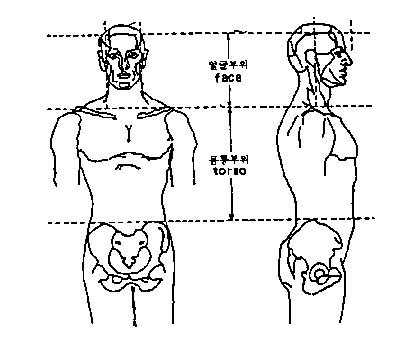
- Legal Scoring Area
- Mid-section of the trunk:
The abdomen and both sides of the
flank.
- Face:
The permitted parts of the face.
- Points shall be awarded when permitted techniques are delivered
accurately and powerfully to the legal scoring areas of the body.
However, when a contestant is knocked down as a result of the opponent's
attack on a part of the trunk protector which is not part of a legal
scoring area, such a technique shall be regarded as a point.
- Each scoring technique shall earn 1 (plus one) point.
- Match score shall be the sum of points of the three rounds.
- Invalidation of points:
When the following are committed, the
delivered technique will not be scored:
- Intentionally falling immediately after delivery of the legitimate
technique.
- Committing an illegal act after delivery of the legitimate
technique.
- Use of any of the prohibited actions.
(Explanation #1) Legal scoring areas
- Trunk:
The valid scoring areas of the trunk are divided into three sections of
the abdomen and both flanks.
The size of each scoring area is depicted in the following illustration.
- Face:
The same as the permitted parts of the face.
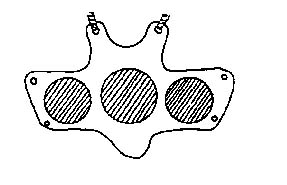
(Explanation #2)
Accurately:
This means the proper aspect
of a legal attacking technique, fully contacting the opponent within the
designated limits of a legal target area.
(Explanation #3)
Powerfully:
- In the use of
electronic scoring trunk protector:
Force of impact is measured by
the electronic sensor of the protector with the level of force by which
points are scored varying by weight division and sex.
- Trunk
protector not equipped with electronic sensor:
Sufficient power is
demonstrated as the opponent's body is abruptly displaced by the impact
of the strike.
(Explanation #4)
Points are given when attacks on to other areas of
the protector than legal scoring areas make the opponent fall into a
critical state. If such attacks result in the following conditions, the
referee must start a count and the judges must award a point. - The contestant is knocked down by the power of the
technique's impact, or
- staggered by the power of the technique's impact or considered to
lose the ability to pursue the match, or
- falls heavily as a
result of the technique's impact.
(Guidelines for Officiating)
In the situation where a contestant falls heavily as a result of the
impact of a technique, if that fall is due in part to the contestant
having lost his/her balance, or been entangled with the other competitor
in a technical exchange, a point cannot be awarded. (Explanation
#5)
Invalidation of a point:
It is a rule that points gained
through illegal techniques or actions cannot be valid. In this situation
the referee must indicate invalidation of the point by hand signal and
declare the appropriate penalty. - Intentional
falling after delivery of an attack:
If a competitor, after
delivery of a scoring technique, seeks to avoid the opponent's
counterattack by intentional failing, the point shall be invalidated.
- Committing a violation after delivery of a legitimate technique:
If a contestant, after delivery of scoring technique, seeks to
avoid or impede the opponent's retaliatory technique by holding,
clinching, stepping on or kicking the opponent's leg, etc., the point is
invalid. However, if the violations occur independently of the scoring
technique, the point remains valid still after declaration of the
penalty. - Use of any of the prohibited actions:
If a point
is gained by using an illegal action or in combination with an illegal
action, the point must be invalidated. (Guidelines for
Officiating)
In the above situation the referee shall immediately
declare "Kal-yeo" and shall first invalidate the point by hand signal,
and then declare the appropriate penalty. If the situation does not
warrant invalidation of the point, then only the penalty is declared.
- Valid points shall be immediately recorded
and publicized.
- In the use of body protectors not equipped with electronics, valid
points shall be immediately marked by each judge by using the electronic
scoring instrument or judge's scoring sheet.
- In the use of electronic trunk protectors:
- Valid points scored on the mid-section of the trunk shall be
recorded automatically by the transmitter in the electronic trunk
protector.
- Valid points scored to the face shall be marked by each judge by
using the electronic scoring instrument or judge's scoring sheet.
- In case of scoring by using the electronic scoring instrument or
judge's scoring sheet, valid points shall be the ones recognized by two
or more judges.
(Interpretation)
It is a
principle of these rules that points shall be awarded immediately. This
principle must be followed regardless of the scoring method used.
(Explanation #1)
Points shall be immediately recorded:
Immediate scoring means awarding the point immediately after delivery of
the scoring technique. Points awarded after a period of time has elapsed
cannot be considered valid. (Explanation #2)
Immediately
recorded and publicized:
A point having been awarded by the judges
shall be immediately publicized on the scoreboard. (Explanation
#3)
Use of trunk protectors not equipped with electronic sensors:
All scoring must be done according to the judge's own decision.
There must be equipment available which is capable of immediately
conveying the recorded point to the scoreboard. However, when electronic
publication equipment is not available, the points shall be immediately
recorded on the judge's scoring sheet and publicized at the end of the
round. (Explanation #4)
The use of electronic protectors:
Scoring techniques striking the body protector will be automatically
recorded. Judges will award points resulting from face attacks or
scoring attacks on areas outside of the scoring targets of the trunk
protector.
(Guidelines for Officiating)
The judges will abide by the principle
of immediate scoring regardless of the scoring system. Awarding a point
at the end of the round is a violation of this regulation.
- Penalties on any prohibited acts shall be
declared by the Referee.
- In the case of multiple penalties being committed simultaneously,
the heavier penalty shall be declared.
- Penalties are divided into "Kyong-go" (warning penalty) and
"Gam-jeom" (deduction penalty).
- Two "Kyong-gos" shall be counted as a deduction of one (1) point.
However, odd "Kyong-go" shall not be counted in the grand total.
- A "Gam-jeom" shall be counted as minus one (-1) point.
- Prohibited Acts: "Kyong-go"
penalty
- Touching Acts
- Grabbing the opponent
- Holding the opponent
- Pushing the opponent
- Touching the opponent with the
trunk
- Negative Acts
- Intentionally
crossing the Alert Line
- Evading by turning the back to the opponent
- Intentionally falling down
- Pretending injury
- Attacking Acts
- Butting or
attacking with the knee
- Intentionally attacking the groin
- Intentionally stamping or kicking any part of the leg or foot
- Hitting the opponent's face with hands or fist
- Undesirable Acts
- Gesturing to
indicate scoring or deduction on the part of the contestant or the coach
- Uttering undesirable remarks or any misconduct on the part of the
contestant or the coach
- Leaving the designated mark on the part of
the coach during match
- Prohibited Acts: "Gam-jeom" penalty
- Touching Acts
- Throwing the
opponent
- Intentionally throwing the opponent by grappling the
opponent's attacking foot in the air with the arm
- Negative Acts
- Crossing the
Boundary Line
- Intentionally interfering with the progress of the
match
- Attacking Acts
- Attacking the
fallen opponent
- Intentionally attacking the back and the back of the
head
- Attacking the opponent's face severely with the hand
- Undesirable Acts
- Violent or
extreme remarks or behavior on the part of the contestant or the
coach
- When a contestant refuses to comply with the Competition Rules or
the referee's order intentionally, the referee may declare the
contestant loser by penalty.
- When the contestant receives minus three (-3) points, the referee
shall declare him/her loser by penalties.
- "Kyong-go" and "Gam-jeom" shall be counted in the total score of the
three rounds.
(Interpretation)
Objectives in establishing the prohibited acts:
- To protect the competitor
- To ensure fair competition
management
- To encourage appropriate or ideal technique
(Explanation #1)
Multiple penalties being committed simultaneously:
In this instance, only the severer penalty may be assessed. For
instance, if a "Kyong-go" penalty and a "Gam-jeom" occur simultaneously,
the "Gam-jeom" must be assessed. If both violations are of equal
severity, the referee will use his/her own discretion in choosing which
penalty to declare. (Explanation #2)
Two "Kyong-gos" shall be
counted as a deduction of one (1) point: However, the final odd
"Kyong-go" shall have no value in the total score. Every two
"Kyong-gos" shall count as minus one point regardless of whether the
committed violations are the same or different acts, and regardless of
the round in which they occur. (Explanation #3) Prohibited acts:
"Kyong-go"
1. Touching acts
- Grabbing the opponent
This includes grabbing any part of the opponent's body, uniform or
protective equipment with the hands. Also included is the act of
grabbing the foot or leg or hooking either one on top of the forearm.
- Holding the opponent with the hand or arm
Pressing the opponent's shoulder with the hand or arm, hooking the
opponent's body with the arm with the intention of hindering the
opponent's motion. If, during the competition the arm passes beyond the
opponent's shoulder or arm for the above mentioned purpose, a penalty
must be declared.
- Pushing with the shoulder, body and hand
- - Pushing to displace the opponent's balance for the purpose of
gaining an advantage in attacking.
- - Pushing to hinder the
opponent's attack or hinder the normal execution of technique.
- - Pushing the opponent's leg after that leg has been hooked by the
arm or caught by the shoulder.
- - Pushing with the fist,
shoulder, trunk or head, etc.
- Touching the opponent with the trunk
Acting to adhere the trunk closely to the opponent in a posture with the
arms outstretched or taken down.
(Guidelines for Officiating)
The above four items (the acts of
grabbing, holding, pushing, touching) are the main reasons to denigrate
Taekwondo competition. It must be recognized that these acts are the
primary means of concealing the discrepancy in technical ability between
two contestants. The contestants must, in principle, maintain an
attitude of sportsmanship with the spirit of fair play, and the referee
must play a role in managing a competition in which the contestants can
exert their best performance under fair match conditions. When any
of the above mentioned acts occur, a penalty must be declared
immediately upon recognition of a violation regardless of the severity
of the violation. However, if both contestants commit one of the acts
simultaneously, the referee must be alert to determine which contestant
instigated the violation. The importance of determining which
contestant instigated the violation is necessary to avoid the
ineffective and unjust act of declaring penalties against both
contestants. For instance, a contestant may be holding as result of
being pushed. Under these circumstances the referee must identify the
contestant initiating the illegal action and declare the appropriate
penalty against him/her.
2. Negative acts
- Intentionally crossing the Alert Line
The
purpose of this sub-article is to punish the act of crossing the Alert
Line with the intention of avoiding the attack of the opponent, or for
the purpose of negative match management. Apart from this, crossing the
Line without relation to the progress of the match must also be seen as
a violation. However, if the Alert Line is crossed unintentionally in
the course of a technical exchange or, one contestant is pushed over the
Line by the opponent's technique, no penalty is assessed. In this case,
determining the intent of the contestant crossing the Line is done by
assessment of performance at the time of crossing the Line. With the
exception of the following three cases, crossing the line must be
regarded as intentional and a penalty must be assessed:
- Crossing the Line in the process of
executing technique.
- Being pushed over the Line by the opponent's
technique.
- Unwillingly losing the capability to stay inside the
Line.
- Evading by turning the back to the opponent
This act involves turning the back to avoid the opponent's attack and
the reasons for punishing this action are the lack of a correct
competition attitude and the fact that this act carries inherent dangers
which could result in serious injury. Included in this act is evading
the opponent's attack by ducking or bending actions which could forfeit
the ability to maintain eye contact with the opponent.
- Intentionally falling
This penalty applies only
to the act of falling with the intention to avoid the opponent's
technique. Therefore, the penalty assessed when intentional evasion is
obvious.
- Pretending injury
Punishing the
absence of the spirit of fair play is the intention of this sub-article.
This means exaggerating injury or indicating pain in a body part not
subjected to a blow for the purpose of demonstrating the opponent's
action as a violation. Also, exaggerating pain for the purpose of
elapsing the game time.
3. Attacking acts
- Butting or attacking with the knee or forehead
This article relates to an intentional butting or attacking with
the knee when in close proximity to the opponent. However, actions of
attacking with the knee such as the following cannot be punished by this
article: - When the opponent rushes in
abruptly to initiate a kicking attack.
- Inadvertently as the
result of a discrepancy in distance a blow occurs.
- Intentionally attacking the groin
This article applies to an intentional attack to the groin. When a blow
to the groin is caused by the recipient of the blow or occurs in the
course of an exchange of techniques, no penalty is assessed.
- Intentionally stamping or kicking any part of the leg or
foot
This article applies to strong kicking or stomping actions to any part
of the thigh, knee or shin for the purpose of interfering with the
opponent's technique, or if these actions occur outside the inadvertent
contact of normal technical exchanges.
- Hitting the opponent's face with hands or fist
This action includes hitting the opponent's face with the hand (fist),
wrist, arm, or elbow. However, unavoidable actions due to the opponent's
carelessness such as excessively lowering the head or carelessly turning
the body cannot be punished by this article. 4. Undesirable
acts
- Gesturing to indicate scoring or deduction on the part
of the contestant or the coach
Gesturing means the act of
waving the hand or fist in an excessive manner in relation to the
competition content during the match. Contestants may not express their
personal judgements or will regarding the technical action except by the
technique itself.
- Uttering undesirable remarks or any misconduct on the part
of the contestant or the coach
In this instance, the undesirable behavior includes physical actions or
attitude which cannot be accepted from the competitor or coach as
amateur sportsmen or Taekwondoins. Details of these actions: - Any actions interfering with the progress of the
competition
- Any action or behavior severely criticizing the
referee's decision or any match officiating by using an irregular method
- Physical or verbal behavior insulting the opposing competitor or
coach
- Loud or excessive coaching
- When any unnecessary or
undesirable act with regard to the contest or any behavior regarding the
contest itself which is not within normally accepted limits is committed
* This article must be understood in relation to "Gam-jeom"
sub-article 4 regarding the degree of illegality and intensity of the
action. In severe cases, sub-article 4 is applied and in less severe
cases this sub-article is used. However, if the less severe cases are
repeatedly seen, sub-article 4 may be used to penalize them.
Distinguishing the above cases is the sole authority of the referee.
When misconduct is committed by a contestant or coach during the rest
period, the referee can immediately declare the penalty and that penalty
shall be recorded on the next round's results.
- Leaving the designated mark on the part of the coach during
match
Any action creating a disturbance by leaving the
coach's mark, or intentional leaving the Competition Area.
(Explanation #4) Prohibited acts: "Gam-jeom" 1. Touching acts
- Throwing the opponent
This action
includes the throwing action as a result of grappling with the hands or
legs.
- Intentionally throwing down the opponent by grappling
the opponent's attacking foot in the air with the arm
Action to interfere with the oponent's attack by grappling the
opponent's foot in the air.
2. Negative acts
- Crossing the Boundary Line
In principle,
the competitors must not cross the Boundary Line at any time during the
course of the match. If a contestant crosses the Boundary Line for any
other than inevitable reasons or as the result of the opponent's
techniques, this shall be punished by "Gam-jeom." In particular,
crossing the Boundary Line directly after the declaration of "Kal-yeo"
for unwarranted reasons shall be strictly penalized.
- Intentionally interfering with the progress of the
match
When the contestant does not return to the Competitor's Mark from the
coaching chair immediately upon the command of the referee or leaves the
Competition Area for the purpose of advantaging themselves in a match.
When the competitor delays immediate resumption of the match after
the declaration of "Kal-yeo" by taking a delaying or circuitous route to
the point of resumption in spite of the referee's order.
3. Attacking acts
- Attacking the fallen opponent
This action is extremely dangerous due to the high probability of injury
to the opponent.
The danger arises from: - The fallen opponent is in
an immediate state of unprotectedness.
- The impact of any
technique which strikes a fallen contestant will be greater due to the
contestant's position. These types of aggressive actions toward a fallen
opponent are not in accordance with the spirit of Taekwondo and so are
not appropriate to Taekwondo competition.
- Intentionally attacking the back and the back of the
head
The part of the back not covered by the protector and
the back of the head are prohibited attacking areas. If an attack is
initially directed towards either of these prohibited areas it is deemed
intentional and the competitor must be penalized. Decision of
intentionality is the judgement of the referee.
- Attacking the opponent's face severely with
hands
Judgement of this violation is made on a two-part basis:
- Apparent lack of caution and/or intentionality of the attacker.
- Impact of the blow and severity of the injury received by the
opponent as well as the opponent's ability to resume the match.
The decision must be made after careful consideration of the above two
factors by the referee. If the action was deemed intentional by the
referee, the penalty must be "Gam-jeom" even if the impact or injury are
slight.
In the case of a lack of caution on the part of the attacker: - If the injury is slight the penalty is "Kyong-go."
- If
the injury is severe the penalty is "Gam-jeom."
- An accidental strike
to the face shall be penalized by "Kyong-go" without regard to the
degree of impact of injury.
4. Undesirable acts
- Violent or extreme remarks on the part of the
contestant or coach
Refer to sub-article 4) of the
"Kyong-go" penalties.
(Explanation #5)
The referee may declare the competitor the loser by
penalty:
The referee can declare a competitor loser without the
accumulation of minus 3 (-3) penalty points when the competitor or coach
ignores or violates the inherent principles of conduct or fundamental
principles of the Competition Rules or the referee's directives.
Particularly, if the competitor shows the intention to injure or commit
a flagrant violation in spite of the referee's cautionary directives,
such a competitor must immediately be declared loser by penalties.
(Explanation #6)
When the contestant receives (-3) points the
referee shall declare him/her loser by penalties:
Minus three points
means a total accumulation of (-3) points, without regard to the
classification as to "Kyong-go" or "Gam-jeom." When a contestant
accumulates (-3) points, that contestant is automatically loser. In this
instance, the referee must declare the other contestant winner
unconditionally.
- In the case of a tie score by deduction of
points, the winner shall be the contestant awarded any point or more
points through the three rounds.
- In the case of a tie score other than case 1 above (where both
contestants received the same number of points and/or deductions), the
winner shall be decided by the referee based on superiority throughout
all three rounds.
- Decision of superiority shall be based on the initiative shown
during the contest.
(Explanation #1)
In the case
of tie score by deduction of points:
The valid points in the
scoring procedure has the highest priority. (Explanation #2)
Throughout all three rounds:
Assessment of superiority is made on
the basis of the overall results of the match without comparison on a
round to round basis and the decision of superiority is made at the end
of the final round. (Explanation #3)
The decision of superiority
shall be made on the basis of the initiative shown...:
- The meaning of "initiative" is technical dominance of an opponent
through aggressive match management.
- If the technical dominance of
one competitor or the other cannot be clearly determined, the referee
may then decide superiority on the basis of the greater number of
techniques executed.
- If there is no clear difference in the number
of techniques executed, superiority is based on the use of the more
advanced techniques both in difficulty and complexity. For example, the
face kick, spinning kick, or jump kick.
- If superiority cannot be
decided by any of the above criteria then it shall be awarded to the
competitor displaying the better competition manner.
- Win by K.O.
- Win by Referee Stop Contest (R.S.C.)
- Win by score or superiority
- Win by withdrawal
- Win by disqualification
- Win by referee's punitive declaration
(Explanation #1)
Win by K.O.:
The referee declares this result
when a competitor cannot resume Competition within 10 seconds after
being knocked down by a legitimate technique. When, as a result of a
blow, the referee determines that a competitor is not fit to resume
competition, this result may be declared before 10 seconds have elapsed.
(Explanation #2)
Referee Stop Contest:
If it is determined
by the judgement of the referee or Commission Doctor that a contestant
cannot continue, even after a one minute recovery period or, when a
contestant disregards the referee's command to continue, the referee
shall declare the contest stopped and the other contestant the winner.
(Explanation #3)
Win by score or superiority:
In this case
the winner is determined by the final score or the decision of
superiority. (Explanation #4)
Win by withdrawal:
The winner
is determined by the withdrawal of the opponent.
- When a contestant withdraws from the match due to injury or other
reasons.
- When a contestant does not resume the match after the rest
period or fails to respond to the call to begin the match.
- When the
coach throws a towel to the Competition Area to signify forfeiture of
the match.
(Explanation #5)
Win by disqualification:
This is the result
determined by the contestant's failure in weigh-in or when the
contestant loses competitor status before the competition begins.
(Explanation #6)
Win by the referee's punitive declarations:
This is the result declared by the referee after the accumulation of
three minus (-3) points or by the referee's decision according to
explanations 14.8 of the Competition Rules.
- When any part of the body other than the
sole of the foot touches the floor due to the force of the opponent's
delivered technique.
- When a contestant is staggered showing no intention or ability to
pursue the match.
- When the referee judges that the contest cannot continue as the
result of any power technique having been delivered.
(Explanation #1)
A knock down:
The situation in
which a contestant is knocked to the floor or is staggered or unable to
respond adequately to the requirements of the match due to a blow. Even
in the absence of these indications, the referee may interpret as a
knock down, the situation where, as the result of contact, it would be
dangerous to continue or when there is any question about the safety of
a contestant.
- When a contestant is knocked down as the result of the opponent's
legitimate attack, the referee shall take the following measures:
- The referee shall keep the attacker away from downed contestant by
declaration of "Kal-yeo" (break).
- The referee shall count aloud from "Ha-nah" (one) up to "Yeol" (ten)
at one second interval towards the downed contestant, making hand
signals indicating the passage of time.
- In case the downed contestant stands up during the referee's count
and desires to continue the fight, the referee shall continue the count
up to "Yeo-dul" (eight) for recovery of the downed contestant. The
referee shall then determine if the contestant is recovered and, if so,
continue the contest by declaration of "Kye-sok" (continue).
- When a contestant who has been knocked down cannot demonstrate the
will to resume the contest by the count of "Yeo-dul," the referee shall
announce the other contestant winner by K.O.
- The count shall be continued even after the end of the round or the
expiration of the match time.
- In case both of the contestants are knocked down, the referee shall
continue counting as long as one of the contestants has not sufficiently
recovered.
- When both of the contestants fail to recover by the count of "Yeol,"
the winner shall be decided upon the match score before the occurrence
of knock down.
- When it is judged by the referee that a contestant is unable to
continue, the referee may decide the winner either without counting or
during the counting.
- Procedures To Be Followed After the Contest
Any contestant suffering a knock-out as the result of a blow to the
head, will not be allowed to compete for the next 30 days. Before
entering a new contest after 30 days, the contestant must be examined by
a medical doctor designated by the National Taekwondo Association, who
must certify that the contestant is recovered and able to compete.
(Explanation #1)
Keep the attacker away:
In this
situation the standing opponent shall return to the respective
Contestant's Mark; however, if the downed contestant is on or near the
opponent's Contestant's Mark, the opponent shall wait at the Alert Line
in front of his/her coach's chair. (Guidelines for officiating)
The referee must be constantly prepared for the sudden occurrence of a
knock down or staggered situation which is usually characterized by a
powerful blow accompanied by dangerous impact. In this situation, the
referee must declare "Kal-yeo" and begin the count without any
hesitation. (Explanation #2)
In case the downed contestant
stands up during the referee's count and desires to continue the
fight:
The primary purpose of counting is to protect the contestant.
Even if the contestant desires to continue the match before the count of
eight is reached, the referee must count until "Yeo-dul" (eight) before
resuming the match. Counting to "Yeo-dul" is compulsory and cannot be
altered by the referee. * Count from one to ten: Ha-nah, Duhl,
Seht, Neht, Da-seot, Yeo-seot, Il-gop, Yeo-dul, A-hop, Yeol.
(Explanation #3)
The referee shall then determine if the contestant
is recovered and, if so, continue the contest by the declaration of
"Kye-sok":
The referee must ascertain the ability of the contestant
to continue while he/she counts until eight. Final confirmation of the
contestant's condition after the count of eight is only procedural and
the referee must not needlessly pass time before resuming the contest.
(Explanation #4)
When a contestant who has been knocked down cannot
express the will to resume by the count of "Yeo-dul," the referee shall
announce the other contestant winner by K.O. after counting to
"Yeol."
The contestant expresses the will to continue the match by gesturing
several times in a fighting position with the clenched fists. If the
contestant cannot display this gesture by the count of "Yeo-dul," the
referee must declare the other contestant winner after first counting
"A-hop" and "Yeol." Expressing the will to continue after the count of
"Yeo-dul" cannot be considered valid.
Even if the contestant
expresses the will to resume by the count of "Yeo-dul," the referee can
continue counting and may declare the contest over if he/she determines
the contestant is incapable of resuming the match. (Explanation
#5)
When it is judged by the referee that a contestant is unable to
continue...:
When a contestant has received an apparently dangerous
blow and has fallen in an urgent condition the referee can suspend the
count and call for first aid or do so in conjunction with the count.
(Guidelines for Officiating)
- The referee must not
spend additional time confirming the competitor's recovery after
counting to "Yeo-dul" as a result of failing to observe the contestant's
condition during the administration of the count.
- When the
contestant clearly recovers before the count of "Yeo-dul" and expresses
the will to resume and the referee can clearly discern the condition of
the contestant yet resumption is hampered by the requirement of medical
treatment, the referee must first resume the match with the declaration
of "Kye-sok" followed immediately by the declarations of "Kal-yeo" and
"Kye-shi" and the procedures of article 19 must then be followed.
- When a contestant is to be stopped due to the injury of one or both
of contestants, the referee shall take the following measures:
- The referee shall suspend the contest by declaration of "Kal-yeo"
and order the Recorder to suspend the time keeping by announcing
"Kye-shi" (suspend).
- The referee shall allow the contestant to receive first aid within
one minute.
- The contestant who does not demonstrate the will to continue the
contest after one minute, even in the case of a slight injury, shall be
declared loser by the referee.
- In case resumption of the contest is impossible after one minute the
contestant causing the injury by a prohibited act to be penalized by
"Gam-jeom" shall be declared loser.
- In case both of the contestants are knocked down and are unable to
continue the contest after one minute, the winner shall be decided upon
points scored before the injuries occurred.
- When it is judged that a contestant's health is at risk due to
losing consciousness or falling in an apparently dangerous condition,
the referee shall suspend the contest immediately and order first aid to
be administered. The referee shall declare as loser the contestant
causing the injury if it is deemed to have resulted from a prohibited
attack to be penalized by "Gam-jeom," and in the case the attack was not
deemed to be penalized by "Gam-jeom," shall decide the winner on the
basis of the score of the match before suspension of the time.
(Explanation #1)
When the referee
determines that the competition cannot be continued due to injury or any
other emergency situation, the referee may take the following
measures:
- If the situation is critical such as a competitor losing
consciousness or suffering a severe injury and time is crucial, first
aid must be immediately directed and the match must be closed. In this
case the result of the match will be decided as follows:
- The causer shall be declared the loser if the
outcome was the result of a prohibited act to be penalized by
"Gam-jeom."
- The incapacitated contestant shall be declared the
loser if the outcome was the result of a legal action or accidental,
unavoidable contact.
- If the outcome was unrelated to the match
contents, the winner shall be decided by the match score before
suspension of the match. If the suspension occurs before the end of the
first round, the match shall be invalidated.
- When the severity of the injury is not serious, the competitor can
receive necessary treatment within one minute after the declaration of
"Kye-shi."
- Permission for medical treatment:
When
the referee determines that medical treatment is necessary, he/she can
direct treatment from the Commission Doctor.
- Order to resume the match:
It is the decision of the referee
whether or not it is possible for the contestant to resume the match.
The referee can, any time, order the contestant to resume the match
within one minute. The referee can declare loser any contestant who does
not follow the order to resume the match. - While the contestant is
receiving medical treatment or is in the process of recovering, 40
seconds after the declaration of "Kye-shi," the referee begins to loudly
announce the passage of time in five second interval. When the
competitor cannot return to the Contestant's Mark by the end of one
minute period, the match results must be declared.
- After the
declaration of "Kye-shi," the one minute time interval is strictly
observed regardless of the Commission Doctor's availability. However,
when the Doctor's treatment is required and the Doctor is absent or
additional treatment is necessary, the one minute time limit can be
suspended by the judgement of the referee.
- If resumption of the
match is impossible after one minute, the decision of the match will be
determined according to Sub-article 1)a. of this Article.
- If both contestants become incapacitated and are unable to resume
the match after one minute or urgent conditions arise, the match result
is decided according to the following criterion:
- If the
outcome is the result of a "Gam-jeom" penalty by one contestant, that
person shall be the loser.
- If the outcome was not related to any
prohibited act to be penalized by "Gam-jeom" the result of the match
shall be determined by the match score at the time of suspension of the
match. However, if the suspension occurs before the end of the first
round, the match shall be invalidated and Organizing Committee will
determine an appropriate time to recontest the match. If, by the
determined rematch time, a contestant is still unable to compete, that
contestant shall be considered withdrawn.
- If the outcome is the
result of prohibited acts to be penalized by "Gam-jeom" by both
contestants, both contestants shall lose.
(Explanation #2)
The situations which warrant suspending the match
beyond the above prescribed procedures shall be treated as follows:
- When uncontrollable circumstances require suspension of the
match, the referee shall suspend the match and follow the directives of
the Organizing Committee.
- If the match is suspended after the
completion of the second round the match shall be determined according
to the match score at the time of suspension if the match cannot be
concluded.
- If the match is suspended before the conclusion of the
second round, a rematch shall, in principle, be conducted and shall be
held in three full rounds.
- Qualifications
Holders of International Referee Certificate registered by the WTF.
- Duties
- Referee
- The referee shall have control over the match.
- The referee shall declare "Shi-jak," "Keu-man," "Kal-yeo," "Kye-sok"
and "Kye-shi," winner and loser, deduction of points, warnings and
retiring. All the referee's declarations shall be made when the results
are confirmed.
- The referee shall have the right to make decisions independently in
accordance with the prescribed rules.
- The referee shall not award points.
- In case of a tie or scoreless match, the decision of superiority
shall be made by the referee after the end of three rounds.
- Judges
- The judges shall mark the valid points immediately.
- The judges shall state their opinions forthrightly when requested by
the referee.
- Responsibility for Judgement
Decisions made by the referees and judges shall be conclusive and they
shall be responsible to the Board of Arbitration for those decisions.
- Uniform of the Referees and Judges
- The referees and judges shall wear the uniform designated by the
WTF.
- The referees and judges shall not carry or take any materials to the
Arena which might interfere with the contest.
The recorder shall time the contest and periods of time-out, suspension,
and also shall record and publicize the awarded points, and /or
deduction of points.
- Composition of refereeing
officials
- In the use of non-electronic trunk protectors:
The officials are
composed of one referee and three judges.
- In the use of electronic trunk protectors:
The officials are
composed of one referee and two judges.
- Assignment of Refereeing Officials
- The assignment of the referees and judges shall be made after the
contest schedule is fixed.
- Referees and judges with the same nationality as that of either
contestant shall not be assigned to such a contest. However, an
exception shall be made for the judges when the number of refereeing
officials is insufficient as the case may be.
(Interpretation)
The details of the qualifications, duties,
organization, etc. shall follow the WTF Regulations on the
Administration of International Referees.
In the case that any matters not specified in the Rules occur, they
shall be dealt with as follows:
- Matters related to the competition shall be
decided through consensus by the refereeing officials of the pertinent
contest.
- Matters which are not related to a specific contest, shall be
decided by the Executive Council or its proxy.
- The organizing committee shall prepare for a video tape recorder at
each court for recording and preservation of the match process.
- Composition of Board of
Arbitration
- Qualifications:
Member of Executive Council of the WTF or person of sufficient Taekwondo
experience recommended by the WTF President or Secretary General.
- Composition:
One chairman and six or less members.
- Procedure of Appointment:
The chairman and members of the Board
of Arbitration will be appointed by the WTF President on the
recommendation of the WTF Secretary General.
- Responsibility
The Board of Arbitration shall make corrections of misjudgments
according to their decision regarding protests and take disciplinary
action against the officials committing the misjudgment or any illegal
behavior and the results of which shall be sent to the Secretariat of
the WTF.
- Procedure of Protest
- In case
there is an objection to a judgement, a delegate must submit an
application for re-evaluation of decision (protest application) together
with the prescribed fee to the Board of Arbitration within 10 minutes
after the pertinent contest.
- Deliberation of re-evaluation shall be carried out excluding those
members with the same nationality as that of either contestant
concerned, and resolution on deliberation shall be made by majority.
- The members of the Board of Arbitration may summon the refereeing
officials for confirmation of events.
- The resolution made by the Board of Arbitration will be final and no
further means of appeal will be applied.
(Interpretation)
Each Board of Arbitration shall be composed of at
least five eligible members and the a number of Board members must be an
odd number. (Explanation #1)
Excluding those members with the
same nationality...:
If there are officials with the same
nationality as either contestant involved on the Board of Arbitration
those members must be excluded from the Board. In all cases, the number
of Board members must be an odd number. If the Chairman is one who is
ineligible, a temporary Chairman must be elected by the remaining
members. (Explanation #2)
Deliberation procedures:
- After reviewing the protest applications, the content of the protest
must be arranged according to the criterion of "acceptable" or
"unacceptable."
- If necessary, the Board can hear opinions from the referee or
judges.
- If necessary, the Board can review the material evidence of the
decision, such as the written or visual recorded data.
- After deliberation, the Board holds a secret ballot to determine a
majority decision.
- The Chairman will make a report documenting the outcome of the
deliberations and shall make this outcome publicly known.
- Treatment of the decision:
- Errors in determining the match
results, mistakes in calculating the match score or misidentifying a
contestant shall result in the decision being reversed.
- Error in application of the rules:
When it is determined by the
Board that the referee made a clear error in applying the Competition
Rules, the outcome of the error shall be corrected and the referee
punished.
- Errors in factual judgement:
When the Board decides that there
was clearly an error in judging the facts such as impact of striking,
severity of action or conduct, intentionality, timing of an act in
relation to a declaration or area, the decision shall not be changed and
the officials seen to have made the error shall be punished.
Referee's Hand
Signals
 1. Call for
Contestants
- Clenching the fist with the thumb on the middle finger, and
forefinger spread out
- Stretching out arms from the breast part,
"Chung" Contestant's Mark shall be pointed first with the right
forefinger, and then "Hong" Contestant's Mark with the left
forefinger.
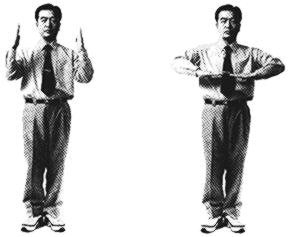 2. Cha-ryeot / Kyong-rye
- Vertically and parallelly raising the palms
of both hands facing each other with the thumbs on the palms and the
other fingers stretched at a height of the eyebrow with the arms
outstretched at an angle of 45 degrees from the points of both
shoulders, and
- Giving a verbal order of "Cha-ryeot," and then,
- Taking down the hands with the palm down to the front of the pit of
the stomach, a verbal order of "Kyong-rye" shall be given. In this case,
a fist-sized space shall be left between both hands and the pit of the
stomach, and the same between both fingertips.
 3. Joon-bi
- Outstretching the crooked right arm at an
angle of 45 degrees from the point of the right shoulder
- Vertically raising the palm of the right open hand at a height of
the ear, and taking a step forward the posture of "Oen-Apkubi" shall be
taken, and then
- Taking down the right open hand in a knife-hand
position to the height of the pit of the stomach, a verbal order of
"Joon-bi" shall be given
- At this point, the left hand lightly
clenched shall be straightened down.
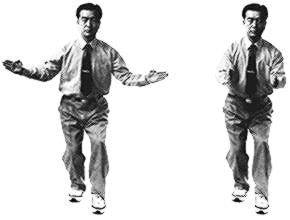
4. Shi-jak
- Taking the posture of "Bum-seogi" from the
posture of "Joon-bi" by withdrawing the left foot back, both arms shall
be outstretched at an angle of 45 degrees from the point of both
shoulders, and then
- With the arms rapidly closing up before the
breast with about 25cm distance, an order of "Shi-jak" shall be
given.
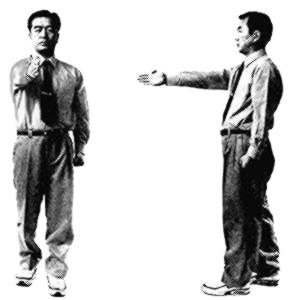 5. Kal-yeo /
Keu-man
Taking a posture of the "Oen-Apseogi," the right open hand shall be
rapidly taken down at a height of the pit of the stomach giving an order
of "Kal-yeo" / "Keu-man."
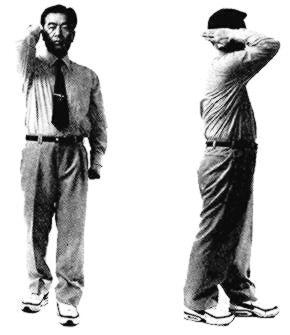 6. Kye-sok
Raising the right knife-hand in the posture of "Kal-yeo" at a height of
the right ear, the order of "Kye-sok" shall be given.
 7. Winner
Declaration
- When "Chung" is the winner, the referee
shall turn towards "Chung" and raise the right fist to the pit of the
stomach, and then immediately stretch the right open hand up at an angle
of 45 degrees declaring "Chung-Seung."
- In case of "Hong," the
referee shall declare "Hong-Seung" by using the left open hand in the
same manner.
- At this point, the other hand lightly clenched shall
be straightened down.
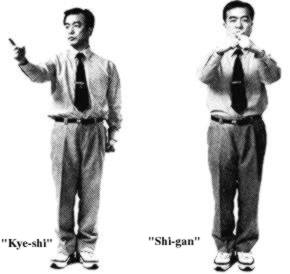 8. Kye-shi
Straightening down the right hand with the arm bent at an angle of 135
degrees, the referee shall point the right forefinger at the Recorder's
seat
9. Shi-gan
This is demonstrated by making an X mark by crossing both forefingers at
a height of the perpendicular furrow of the upper lip.
 10. Counting
The count shall be made from the right thumb by spreading out the
fingers of the clenched fist one by one at one second interval giving a
verbal count. When the count reaches "Da-seot" (five) and "Yeol" (ten),
the palm shall be turned toward the pertinent contestant.
Kyong-go Penalty
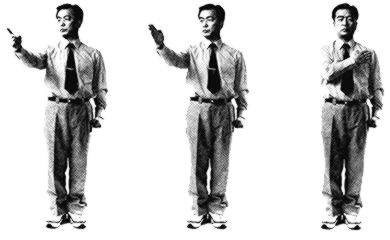 1. Touching
Acts
- Looking at the pertinent contestant in the
posture of "Cha-reot," the referee shall point the right forefinger at
the contestant, and
- Putting the right palm on the left breast
(the right middle finger to reach the left shoulder blade), "Kyong-go
shall be declared.
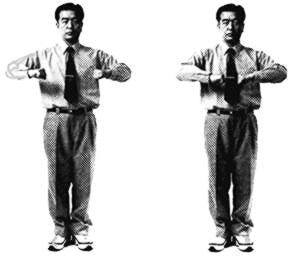 2. Negative
Acts
The motion of two times' bumping leaving an interval of a fist between
the two clenched fists in front of the pit of the stomach.
 3. Attacking
Acts
Vertically raising the left palm up to the height of the shoulder, one
time's punching with the right fist shall be given on the left
palm.
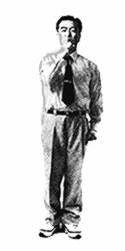 4. Undesirable
Acts
The motion of bringing the right forefinger to the lips leaving an
interval of 5cm between the lips and the forefinger.
1. Motion of Kyong-go Declaration
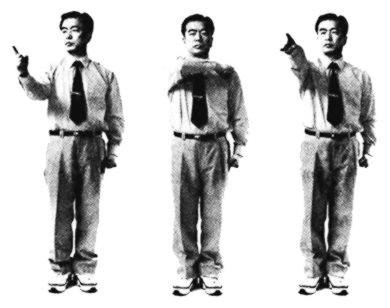
- The referee declares "Kal-Yeo" and at that position takes the
posture of "Char-yeot" towards the pertinent contestant. Spreading out
the right arm at the interior angle of 135 degrees and pointing the
right forefinger at the forehead of the pertinent contestant
- And
then bringing the right forefinger to the left shoulder,
- Pointing
the right forefinger at the forehead of the contestant by spreading out
the arm, the referee shall make a verbal declaration of "Kyong-go."
2. Motion of Gam-jeom Declaration
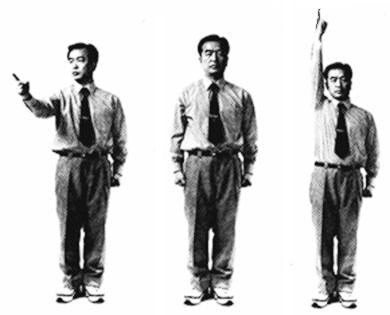 All the motions are the same as those
of "Kyong-go" penalty with the exception of the motion of "Gam-jeum"
declaration.
- Let the two contestants of "Chung" and
"Hong" stand at their positions. After pointing at the pertinent
contestant in the posture of "Char-yeot" as in the procedure of
"Kyong-go" declaration,
- Straightly raising the right fist tightly
clenched with the forefinger spread out, the referee shall make a verbal
declaration of "Gam-jeum."
3. Motion to annul the points scored
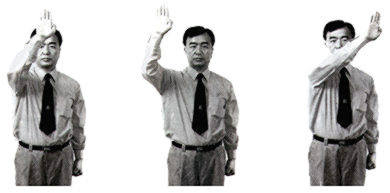 All the motions are the
same as those of "Kyong-go" penalty with the exception of the motion of
"Gam-jeum" declaration.
- With regard to the Article 12.5 of the
Competition Rules, annul the points scored as mentioned in 2) and 3)
immediately after declaration "Kal-yeo."
- In the stance of
"Char-yeot," rasie the right open hand to the point 20cm horizontally
away from the forehead with the palm forward and the wrist at the height
of the forehead.
- Shake the hand horizontally 30cm to the right
and then 50cm to the left, naturally turning towards the pertinent
contestant. Repeat this twice.
- Show the sign of "Shi-gan" to the
recorder and declare the penalty to the pertinent competitor. Time shall
be recorded again from the point of declaration of "Kye-sok" after
giving the penalty.
Orthography and phonetic
symbols
of Taekwondo terms
|
Term
|
Pronunciation
|
Meaning
|
|
1. Chung
|
chung
|
Blue
|
|
2. Hong
|
hawng
|
Red
|
|
3. Charyeot
|
tcha riet
|
Attention
|
|
4. Kyeong-rye
|
kieng ney
|
Bow
|
|
5. Joon-bi
|
djoonbee
|
Ready
|
|
6. Shi-jak
|
shi dzahk
|
Start
|
|
7. Kal-yeo
|
kal yo
|
Break
|
|
8. Keu-man
|
ku mahn
|
Stop
|
|
9. Kye-sok
|
ke sok
|
Continue
|
|
10. Kye-shi
|
ke shee
|
Suspension of match due to injury
|
|
11. Shi-gan
|
shee gan
|
Suspension of match for other case
|
|
12. Kyong-go
|
kyawng go
|
Warning penalty
|
|
13. Gam-jeom
|
gahm jum
|
Deduction penalty
|
|
14. Chung Seung
|
chung soong
|
Chung winner
|
|
15. Hong Seung
|
hawng soong
|
Hong winner
|
|
16. Ha-nah
|
hah nah
|
One
|
|
17. Duhl
|
dool
|
Two | | 18. Seht | set |
Three | |
19. Neht |
net | Four |
| 20.
Da-seot | da
soot | Five |
| 21. Yeo-seot |
yu soot | Six | | 22. Il-gop | il gob | Seven | | 23. Yeo-dul | yu duhl | Eight | | 24. A-hop | ah hob | Nine | | 25. Yeol | yool | Ten | | 26. Hyu-sik | hju sik |
Rest |
Enacted: May 28, 1973
Revised: October 1, 1977
Revised: February 23, 1982
Revised: October 19, 1983
Revised:
June 1, 1986
Revised: October 7, 1989
Revised: October 28,
1991
Revised: August 17, 1993
Revised: November 18, 1997
Printed: Jan. 11, 1999
|
![[General Taekwondo Information]](pics/gti.jpeg)




















